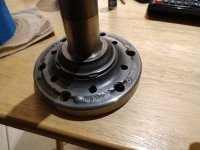Five.five-six
New member
- May 6, 2021
- 494
- 341
Well, things are going in the right direction... I’m putting things back on the car. This is about as stripped as it got:

I got the transmission and new CV’s back from the builder a few weeks ago and installed the trans and new CVs and bought new axels because there was some question as to if they had been turned around... and for good measure, I stopped at Kartek for some washers and stub axel bearings and they sold me a new set of one piece chromoly stub axles.

One piece stub axles

Great big fan for my 14” X 14” setrab oil cooler

We did the math and used a calculator and it turns out that I’m going to need 80 pound injectors with E85 which will make it hard to idle so the decision was made to do 2 40 pound injectors per hole. Also, sequential fuel pumps and a fuel accumulater and lift pump have been added to the design.
I need to get my 2376 engine out to my builder so he can split it and get started. Once that’s done, I’ll have the exhaust made

I got the transmission and new CV’s back from the builder a few weeks ago and installed the trans and new CVs and bought new axels because there was some question as to if they had been turned around... and for good measure, I stopped at Kartek for some washers and stub axel bearings and they sold me a new set of one piece chromoly stub axles.

One piece stub axles

Great big fan for my 14” X 14” setrab oil cooler

We did the math and used a calculator and it turns out that I’m going to need 80 pound injectors with E85 which will make it hard to idle so the decision was made to do 2 40 pound injectors per hole. Also, sequential fuel pumps and a fuel accumulater and lift pump have been added to the design.
I need to get my 2376 engine out to my builder so he can split it and get started. Once that’s done, I’ll have the exhaust made
Last edited by a moderator:



